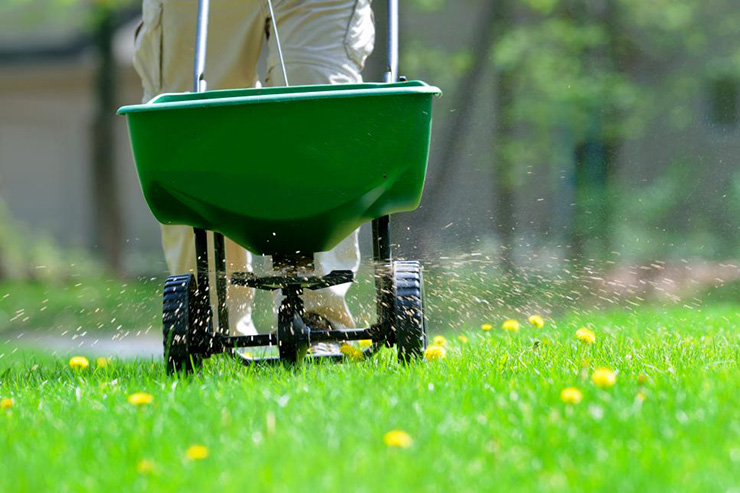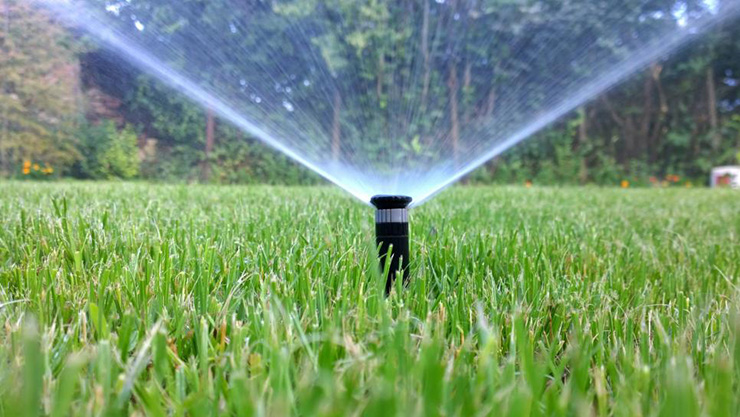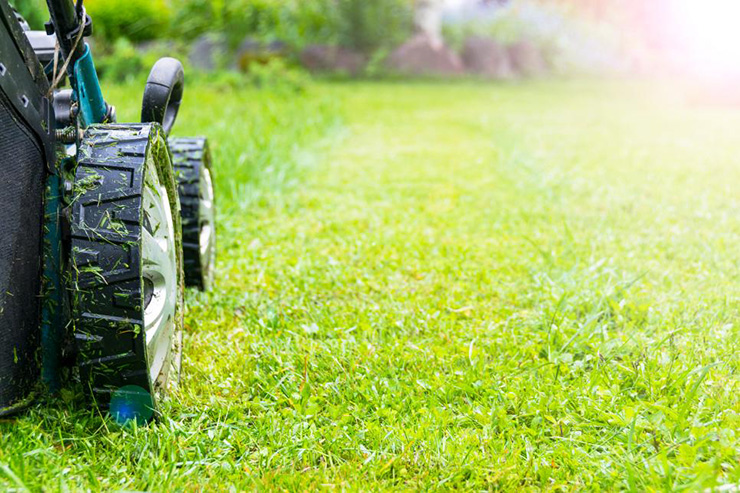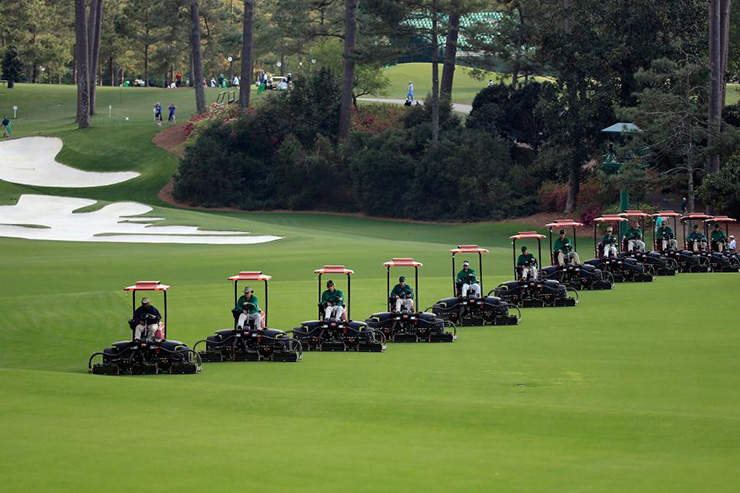Despite what you think, your playing partners don’t care what you shoot. Your lawn is the same. Unless it’s exceptionally good or bad, no one else thinks about your yard as much as you do. But you care about your lawn, and we care about ours, and that’s why we’re here.
It might be unrealistic to maintain the same quality turf conditions as a golf course without a five- or six-figure maintenance budget, but we spoke to a few superintendents at top clubs across the Northeast who believe you can have a healthy yard simply by following a few of tricks of the trade.
To learn some of the strategies that superintendents use that we can apply at home, we talked with Jason Meersman, director of grounds at The Patterson Club in Fairfield, Conn., and Steve Aspinall, superintendent at Watchung Valley Golf Club in Watchung, N.J. Here are 7 tips for a golf-course-quality lawn that they emphasized above all others.
1. Take it easy on fertilizer
Both Aspinall and Meersman say that in virtually all aspects of at-home lawn care, less is more. “Typical problems people have are self-induced,” Aspinall says. “With people who are really trying to take care of their lawns, a lot of them mow the grass too low, overfertilize and overwater.”
Aspinall and Meersman agree that you only need to fertilize your lawn two or three times a year. “If you put too much fertilizer out, sure, your grass is going to look green, but your root system is probably going to be horrific,” Aspinall says. “You want the plant to be stronger, and you’re not going to get any stronger by force feeding it.”
Meersman says that overfertilizing is just making more work for yourself. “The more fertilizer you add,” he says, “the more water you might need, the more fungicides you might need, so the more mowing you’re going to do.”
2. Stick to a simple plan

groveb
Since you’re only going to be applying fertilizer a few times a year, the timing is vital. Both superintendents recommend applying crabgrass and grub preventative early in the spring. “The only two things that can really mess up a lawn where you can’t get it back once its already happened are grubs and crabgrass,” says Meersman, who has been at The Patterson Club for 12 years.
Meersman uses a product called One and Done, which protects against white grubs and crabgrass. The fertilizer includes an insecticide, Acelepryn, as well as an herbicide, Dimension. Aspinall also uses this combo, both at Watchung Valley and at home. People in northern climates should apply this fertilizer in late April or early May before the crabgrass comes up.
Aspinall applies more insecticide in late July or early August to kill the Japanese beetles that lay eggs which turn into grubs. Meersman uses gypsum and lime several times throughout the year. “Gypsum will help make the nutrients that are already in the soil plant available, and then the lime will help open up the soil a little bit for root growth,” Meersman says.
3. Wash fertilizer into the soil

Nenov
Simply dropping fertilizer on your lawn is not enough, however. It needs to soak into the ground to have its full effect, so both superintendents drop their fertilizer before a rainstorm, which flushes the product down into the soil. If there are no storms in the forecast—common in the drier climates of the Southwest—make sure to run your irrigation system or hand water your lawn right after putting the product down.
“You have about a week, a week-and-a-half window where it needs to be watered in by, or it starts to degrade in the sunlight and becomes less effective,” Aspinall says.
4. Be careful when applying product
One of the most common mistakes Meersman sees homeowners make is not applying products correctly. “I have a neighbor who used a drop spreader when they were supposed to use a broadcast spreader, and they killed a lot of grass in their yard,” he says. To avoid misapplying fertilizer, be sure to read the bag. Most products will have instructions that say what spreader to use and what setting to put it at. Meersman also explains that you need to apply product evenly across your lawn, as missing spots or overlapping in one area can ruin the grass in those places.
5. Mind the water
Once again, less is more. “You see a lot of people who have sprinklers on every single night no matter what,” Aspinall says. “I don’t even do that on a green, which I’m cutting at a tenth of an inch. Your yard doesn’t need to be that wet.”
Aspinall and Meersman suggest short watering sessions every few days instead of nightly soaks. Aspinall recommends heavy watering for 20 minutes every couple of days. It’s important for the water to penetrate into the ground, so it’s better to water heavily for short periods instead of lighter and longer.
“The more water you have, the more saturated your soils are, and the less happy your plants are going to be,” Meersman says. “If somebody is running their irrigation system for 20 minutes every night, most likely they’re getting way too much water, and that can be detrimental.” He adds that the longest he’ll water the greens at Patterson is six minutes at a time (not including after an aeration).
6. Keep your grass tall (but not too tall)

bigtunaonline
It’s important to find the middle ground with your grass length—not quite as short as a fairway but not as long as U.S. Open rough. “Two-and-a-half to three inches is ideal,” Meersman says. The rule of thumb is that the less light your yard gets, the longer you should keep the grass. “Grass is basically a solar panel,” Meersman explains, “so the longer it is, the more panels it has.”
Usually, mowing about once a week is all you need. In drier, hotter months like July and August, Meersman sometimes will only mow his lawn once a month. “It definitely doesn’t want the stress of getting a haircut,” he says.
Aspinall adds that it’s important to keep a routine and not let the grass get too long before a shave. “You need to constantly be cutting the grass to train it to be at whatever height you want it to be at,” he says. “It’s like a putting green. You can’t mow a putting green once every three days and expect a good product.”
Your specific mowing routine takes a bit of feel and will vary throughout the season. Find whatever frequency you need to keep your lawn around three inches.
7. Aerate every two years
Though Meersman says you don’t need to follow a rigid and frequent aerification schedule like golf courses, but you should aerate your lawn once every two years. Doing so will help loosen the soil and create channels for even water distribution, helping to maintain good turf health. “I call it fluffing the pillow,” he says. “It relaxes the soil a little bit.” You likely won’t have access to the large aerifying machines used at courses, but smaller versions available for rent at hardware stores do a decent job, Meersman says.
Main image: Rob Carr









